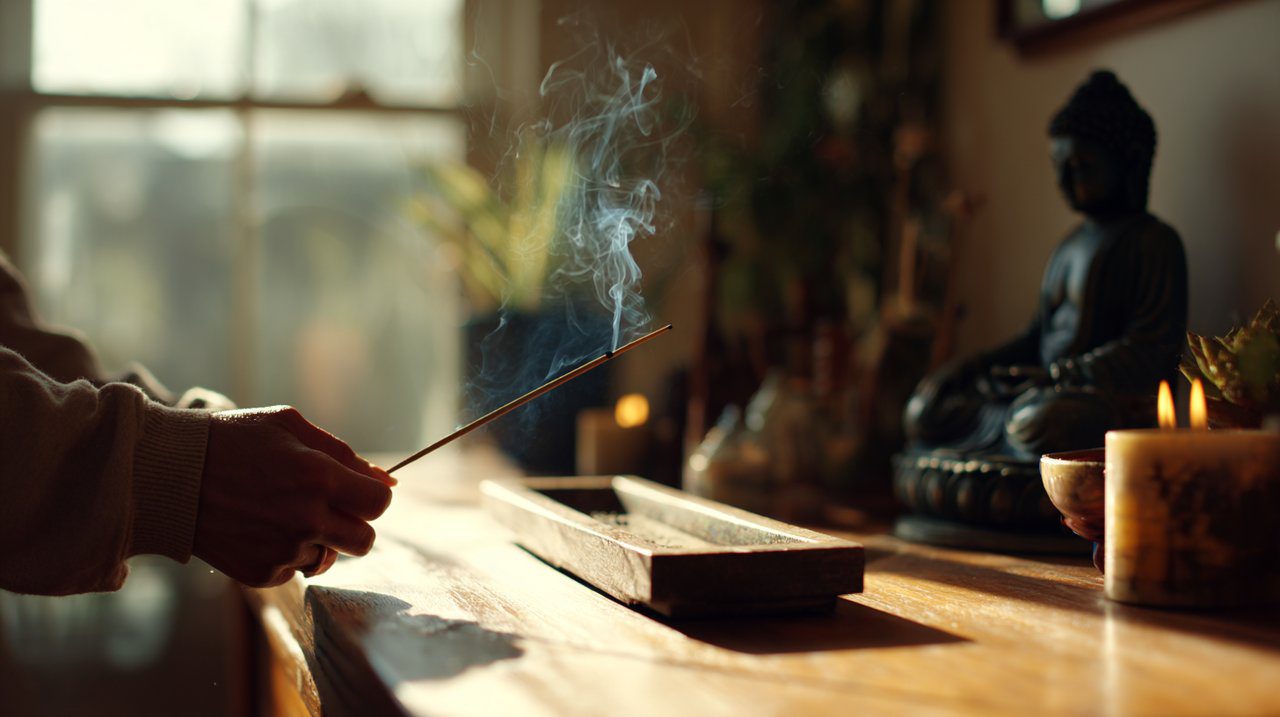Buddhism and Incense: A Comprehensive Guide to Spiritual Meaning, Rituals & Purification
The subtle, yet undeniably potent, scent of incense has graced Buddhist temples and homes for thousands of years. Far from being a mere aromatic embellishment, incense serves as a profound, multi-layered symbol woven deeply into the spiritual fabric of Buddhism. It’s a gentle guide, leading practitioners toward mindfulness, purification, and a deeper understanding of impermanence. While many ancient traditions use incense, its specific interpretation within Buddhism offers unique and powerful insights into the path to enlightenment.

The Ephemeral Essence: Incense as a Gateway to Buddhist Philosophy
Think of incense in Buddhism as a sensory bridge, connecting us directly to abstract spiritual concepts. Its journey from a solid stick to fragrant, dissipating smoke is a powerful metaphor. This transformation beautifully mirrors fundamental Buddhist teachings, inviting practitioners to contemplate deeper, often elusive, truths.
Symbolism of Scent: Purity, Mindfulness, and Offering
The rising smoke of incense carries several key symbolic meanings, each offering a distinct lesson. What are these profound messages?
- It embodies purity, cleansing the environment and preparing our minds for meditation or prayer.
- The very act of lighting and observing the incense cultivates mindfulness, gently drawing our attention to the precious present moment.
- And finally, offering incense is a beautiful act of generosity and devotion, a selfless gift to the Buddhas and Bodhisattvas, symbolizing our deepest spiritual aspirations.
The Breath of Impermanence: A Meditative Metaphor
Perhaps the most profound symbolism of incense lies in its direct connection to anitya, the Buddhist concept of impermanence. Just like life itself, the smoke, once vibrant and fragrant, gradually dissipates into thin air. This visual and olfactory metaphor serves as an incredibly powerful tool for meditation, fostering detachment and acceptance of life’s transient nature.
“Like the smoke that rises and vanishes, so too are our lives and all worldly attachments.”
This profound contemplation truly helps practitioners release their grip on fleeting experiences, guiding them towards inner peace.
Aromatic Pathways: Incense in Buddhist Rituals and Practice
Incense isn’t just symbolic; it’s an indispensable element in countless Buddhist rituals, from simple daily devotions to the most elaborate ceremonies. Its consistent presence acts as a powerful enhancer, deepening the spiritual atmosphere and helping to focus the mind during practice.
Daily Devotion and Sacred Spaces
For many, lighting incense is a cherished daily ritual, whether in a bustling monastery or a quiet home. It beautifully marks the beginning of morning prayers or meditation, effectively consecrating the space. The calming fragrance then envelops the environment, creating a serene sanctuary perfect for spiritual practice.

Grand Ceremonies and Offerings
When it comes to grand ceremonies, festivals, or special observances, you’ll often find larger quantities and a wider variety of incense being used. These significant offerings are frequently accompanied by chanting, prostrations, and other ritual objects, such as mala beads for counting mantras. The collective aroma here isn’t just personal; it profoundly enhances the communal spiritual experience for everyone present.
Guidance for Mindful Incense Use
Mindful incense use extends even to the practicalities, like choosing the right incense burners and types (be it sticks, cones, or powdered blends). Remember, it’s never about the cost or extravagance of the incense itself. What truly matters is the pure intention behind the offering – creating a sacred atmosphere and directing your mind wholeheartedly towards your spiritual goals.
Cleansing the Spirit: Incense for Purification and Transformation
The idea of purification through incense goes far beyond simple physical cleansing; it truly embraces a deeper mental and spiritual transformation. This profound, transformative aspect is absolutely central to incense’s integral role within Buddhist practice.
Internal Purification: Clearing the Mind
When we offer incense with focused intention, it actively helps to purify our minds, clearing away negative thoughts, defilements, and distractions. The calming aroma itself aids in settling the mind, making it far more receptive to meditation and wisdom. This profound internal cleansing is truly a key aspect of many Buddhist purification rituals.
External Purification: Consecrating Space
Beyond our individual minds, incense is also powerfully used to purify and consecrate physical spaces. Temples, meditation halls, and personal altars are regularly cleansed with its smoke, dispelling negative energies and inviting auspiciousness. This essential practice creates a true sanctuary where spiritual growth can flourish unobstructed.
Beyond the Smoke: Incense in Diverse Buddhist Traditions
While the core spiritual meaning of incense remains consistently profound, its practical application and specific types vary quite significantly across different Buddhist schools and cultures. Exploring these fascinating variations only deepens our appreciation for its universal, yet diverse, role.
Tibetan Buddhism: Blends and Blessings
In Tibetan Buddhism, for instance, you’ll often encounter complex blends of herbs, resins, and spices in their incense, revered for their potent purifying and healing properties. These unique incense powders or sticks are integral to tantric rituals, offerings to deities, and creating truly conducive environments for deep meditation. It’s a rich practice, frequently combined with the rhythmic spinning of tibetan prayer wheels and the recitation of powerful mantras.

Zen and Pure Land: Simplicity and Focus
In stark contrast, Zen and Pure Land traditions often favor a simpler, more subtle incense, placing a strong emphasis on clarity and focused presence over elaborate blends. Here, the ritual of lighting incense transforms into a direct act of mindfulness—a single, deliberate gesture to mark the beginning of zazen (sitting meditation) or a devotional practice. This beautiful simplicity truly underscores their direct path to awakening.
The universal human desire to clear both space and mind is a fascinating thread woven across countless cultures, from Buddhist incense offerings to Native American smudging ceremonies. While the methods and specific beliefs may differ, the profound shared intention for purification and connection to the sacred remains constant.
So, as we reflect on our journey with incense in Buddhism, we see it truly is a profound one. It extends far beyond its fragrant smoke to touch the very essence of spiritual practice itself. This simple yet powerful tool is indeed a constant reminder of impermanence, a gentle aid to mindfulness, and a powerful conduit for purification and devotion.
As the smoke gracefully dissipates, it leaves behind not emptiness, but a lingering sense of peace and clarity—a subtle invitation to deeper understanding. Ultimately, to truly grasp its power, we must engage with it not just as a fleeting scent, but as a silent, wise teacher guiding us on the path to enlightenment.
💡 よくある質問
In Buddhism, incense primarily symbolizes purity, acting as a cleanser for both the environment and the mind. It also cultivates mindfulness by drawing attention to the present moment and serves as an act of offering and devotion to Buddhas and Bodhisattvas, representing spiritual aspirations.
The dissipating smoke of incense is a powerful metaphor for anitya, the Buddhist concept of impermanence. Just as the smoke vanishes into thin air, so too do our lives and worldly attachments. This contemplation helps practitioners detach from fleeting experiences and find inner peace.
Incense is a key element in Buddhist rituals, enhancing spiritual atmosphere and focusing the mind. It's used in daily devotions to mark the start of prayers or meditation and consecrate sacred spaces. In grand ceremonies, larger quantities and varieties are used to deepen the communal spiritual experience.
Incense aids in internal purification by helping to clear negative thoughts, defilements, and distractions from the mind, making it more receptive to meditation and wisdom. Externally, it purifies and consecrates physical spaces like temples and altars, dispelling negative energies and inviting auspiciousness.
Tibetan Buddhism often uses complex blends of herbs and resins for potent purifying and healing properties in tantric rituals. In contrast, Zen and Pure Land traditions favor simpler incense, emphasizing clarity and mindfulness, where lighting incense is a direct act of presence during meditation.







